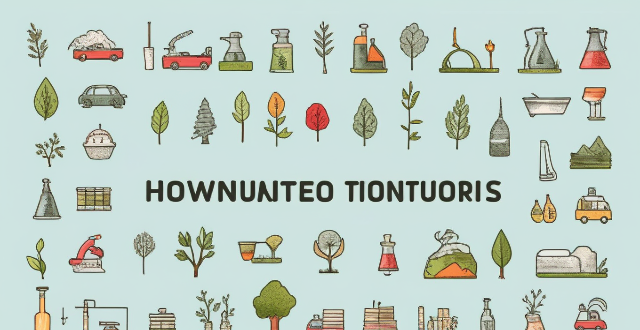Cultural Awareness

How do cultural factors influence waste reduction practices ?
The text provides an overview of how cultural factors influence waste reduction practices, highlighting the role of cultural attitudes, social norms, education, religious beliefs, economic conditions, and technological advancements in shaping waste management behaviors. It emphasizes that respect for resources, consumerism vs. conservatism, composting traditions, public awareness campaigns, community cleanliness standards, taboos around waste, environmental education, family values, role models, stewardship principles, reincarnation beliefs, interconnectedness philosophies, affordability of disposable products, recycling costs, government incentives, access to technology, digital awareness campaigns, and innovative product design are all aspects of culture that can significantly impact waste reduction efforts. By understanding these cultural dynamics, more effective strategies for sustainable living can be developed globally.

How do sports exchange programs contribute to cultural awareness and appreciation among youth ?
Sports exchange programs offer young athletes a platform to engage in cultural exchanges and foster cultural awareness and appreciation. These programs expose youth to different cultures, promote language learning, and include cultural exchange activities that break down cultural barriers. Additionally, sports exchange programs celebrate diversity, build lasting friendships, and encourage the embrace of cultural differences, contributing to a more harmonious global community.

What are the benefits of embarking on a cultural exploration journey ?
Embarking on a cultural exploration journey is an enriching experience that offers numerous benefits, including expanding your horizons, enhancing communication skills, boosting creativity, developing cultural sensitivity, strengthening adaptability, building global awareness, forging lasting connections, and promoting personal growth and self-discovery.

How do food festivals promote cultural diversity and understanding ?
Food festivals are significant events that promote cultural diversity and understanding by offering educational opportunities, exposing attendees to new flavors, building community, impacting the economy positively, providing entertainment, enhancing social media presence and awareness, and promoting sustainability initiatives. These festivals facilitate cross-cultural dialogue, break down cultural barriers, and encourage a shared appreciation for global cuisine.

What challenges do we face in implementing resource-efficient utilization globally ?
Implementing resource-efficient utilization globally presents several challenges, including lack of awareness and education, economic barriers, technological limitations, legal and policy constraints, and cultural differences. Addressing these challenges will require a multifaceted approach that involves raising awareness, providing economic incentives, investing in research and development, creating supportive policies and regulations, and fostering cross-cultural understanding and collaboration.

What are the benefits and drawbacks of cultural fusion in education systems ?
Cultural fusion in education systems can enhance global awareness and improve intercultural communication, but it may also lead to a loss of cultural identity and stereotyping. To maximize its benefits, cultural fusion should be implemented thoughtfully and effectively.

Can cultural fusion lead to a loss of cultural identity ?
Cultural fusion, the blending of different cultures, has been a phenomenon for centuries. However, with globalization and the rise of social media, cultural fusion has become more prevalent than ever before. While it can lead to the creation of new and exciting cultural expressions, it can also raise concerns about the potential loss of cultural identity. This article explores whether cultural fusion can indeed lead to a loss of cultural identity by examining the benefits of cultural fusion, the potential loss of cultural identity, and ways to maintain cultural identity amidst fusion.

How can we promote cultural diversity in our community ?
Promoting cultural diversity is crucial for fostering understanding and respect among people from different backgrounds. To achieve this, we can organize cultural events, promote multicultural education, encourage intercultural dialogue, support local businesses owned by diverse individuals, increase diverse representation in media, and promote cultural exchange programs. By embracing these strategies, we can create an inclusive and harmonious society where everyone feels valued and respected.

How can education and awareness programs support climate adaptation ?
Education and awareness programs are crucial for climate adaptation, empowering individuals, communities, and policymakers with knowledge and skills to understand and respond to climate change impacts. These programs can raise public awareness, enhance decision-making capabilities, build resilience, promote sustainable practices, and facilitate behavioral change. Key actions for implementing effective education and awareness programs include curriculum integration, public campaigns, community workshops, and partnership initiatives.

What are the benefits of cultural exchange ?
Cultural exchange is the process of sharing and learning from each other's cultures, promoting understanding, tolerance, and appreciation for diversity. It offers benefits such as enhancing cultural awareness and sensitivity, promoting tolerance and acceptance, encouraging creativity and innovation, and building international relations and peace. Examples include traveling abroad, participating in international events, multicultural classrooms, interfaith dialogues, collaborative projects between artists, exchanging business practices, international cultural festivals, and international student exchange programs. Cultural exchange has the potential to create a more harmonious world where people appreciate and celebrate diversity while working together towards common goals.

How can ecological protection areas contribute to environmental education and awareness ?
Ecological protection areas are crucial for both biodiversity conservation and environmental education. These areas offer hands-on learning experiences, interactive programs, sustainable practice promotion, community outreach, research efforts, and media publicity to raise awareness about the importance of preserving ecosystems. Through these initiatives, ecological protection areas can inspire individuals to adopt eco-friendly habits and contribute to global conservation efforts.

What is the impact of cultural exchange on globalization ?
This essay explores the impact of cultural exchange on globalization. It states that cultural exchange plays a crucial role in enhancing mutual understanding and respect among nations, promoting economic growth and development, fostering international collaboration and cooperation, encouraging tourism and travel, and preserving cultural heritage and traditions. The essay concludes that as our world becomes increasingly interconnected, cultural exchange will continue to play a vital role in shaping our future together.

What are the latest revelations from popular variety shows ?
This text discusses the latest revelations from popular variety shows, including celebrity relationships, behind-the-scenes secrets, cultural exchange, and social issues. It highlights how these shows provide a platform for celebrities to showcase their talents, share experiences, and interact with each other in a fun and lighthearted manner. The text also mentions how variety shows have become a source of information about various aspects of the entertainment industry, such as actor training, music production, international collaborations, language learning, mental health awareness, and environmental concerns. Overall, the text emphasizes the importance of variety shows in promoting cultural exchange, raising awareness about social issues, and providing entertainment to viewers worldwide.

How do cultural beliefs and values influence attitudes towards climate change ?
Cultural beliefs and values play a significant role in shaping individuals' attitudes towards climate change. These cultural factors include worldviews, religious beliefs, social norms, historical experience, and education and awareness levels. Understanding these cultural influences can help promote actions that address climate change while respecting diverse perspectives.

What role does art play in cultural exchange ?
Art is a powerful medium for cultural exchange, promoting understanding and empathy between different societies. It transcends language barriers and connects people on a deeper level. Art can facilitate mutual understanding by exposing individuals to diverse perspectives and experiences. Visual arts provide a visual representation of culture, while performing arts offer a dynamic form of cultural exchange. Literary arts explore the inner workings of a culture through its stories and narratives. Art also promotes creativity and innovation within cultures, encouraging experimentation with new ideas. Artistic collaborations between artists from different cultures can result in groundbreaking works that blend traditional elements with modern influences. Art serves as a means of preserving cultural heritage, documenting the history, traditions, and customs of a society. Museums and galleries showcase art from different cultures, promoting cultural awareness and appreciation among the public. Cultural festivals celebrate the artistic achievements of different cultures through various forms of performance. Overall, art plays a vital role in cultural exchange by enhancing mutual understanding, promoting creativity and innovation, and preserving cultural heritage.

In what ways can cultural diversity be embraced to foster social harmony ?
Cultural diversity is a rich tapestry that weaves together various beliefs, practices, and traditions of different groups within a society. Embracing cultural diversity is not just about celebrating differences; it's about creating an environment where everyone feels valued, respected, and included. Here are some ways to foster social harmony through the embrace of cultural diversity: Education and Awareness: Integrate diverse perspectives into the curriculum, teach history from multiple viewpoints, include literature and art from different cultures, encourage student and teacher exchanges, organize international conferences and workshops, partner with schools abroad for virtual interactions. Community Involvement: Host multicultural festivals showcasing different traditions, celebrate national holidays from various countries, organize cultural fairs with food, music, and dance, collaborate on projects that benefit all communities, volunteer in diverse neighborhoods, support local businesses owned by immigrants. Media Representation: Ensure media portrays a wide range of cultural backgrounds, avoid stereotyping and promote accurate representations, include diverse voices in news reporting and commentary, create platforms for underrepresented groups to share their stories, translate important information into multiple languages, use technology to bridge language barriers. Workplace Inclusivity: Implement policies that value cultural differences, provide training on cultural sensitivity and awareness, foster an inclusive environment through open communication, encourage the formation of ERGs for different cultural backgrounds, support these groups with resources and recognition, use ERGs as a platform for knowledge sharing and networking. Legal and Policy Frameworks: Strengthen laws against discrimination based on race, ethnicity or culture, enforce these laws fairly and consistently, educate the public on their rights and protections, implement programs to level the playing field for marginalized groups, address historical inequalities through targeted initiatives, monitor progress and adjust strategies as needed. Interfaith Dialogue: Promote understanding between different faiths, organize interfaith events like dialogues, seminars, and celebrations, educate people about the commonalities across religions, create neutral spaces for people of all faiths to gather, encourage community centers to host interfaith activities, provide resources for religious accommodation in public settings. Artistic Expression: Fund arts programs that showcase diverse artistic traditions, offer grants to artists from minority backgrounds, display public art that reflects the cultural mosaic of the community, curate exhibits that tell the stories of different cultures, make museums accessible to all through free entry days or low admission fees, collaborate with community members in the exhibition process.

What role do governments play in promoting cultural understanding and acceptance in a multicultural society ?
Governments can promote cultural understanding and acceptance in multicultural societies by implementing policies and programs that foster diversity, inclusion, and respect for different cultures. They can launch education and awareness campaigns, enact legislation and policies, engage with communities and partner with NGOs, and promote international cooperation to create an environment where diversity is celebrated, respected, and embraced.

What challenges do businesses face when dealing with cultural diversity ?
Businesses operating globally face challenges with cultural diversity impacting communication, decision-making, and productivity. Key challenges include: 1. **Communication Barriers** due to language differences, non-verbal cues, translation issues, and accents/dialects. 2. **Cultural Stereotyping** leading to generalizations, lack of awareness, and assumptions based on cultural backgrounds. 3. **Values and Beliefs Conflicts** arising from work ethic variations, religious practices, and differing attitudes toward gender roles. 4. **Legal and Ethical Considerations** such as navigating employment laws, ethical standards, and data privacy regulations. 5. **Organizational Practices** including management styles, decision-making processes, and feedback mechanisms that vary across cultures. 6. **Adaptation and Change Management** challenges like resistance to change, training needs, and continuous learning requirements. Addressing these challenges requires proactive strategies to ensure all employees feel valued, respected, and can contribute to the organization's success.

How can we ensure that climate education and awareness efforts are accessible and relevant to diverse communities ?
The text discusses strategies for making climate education more inclusive and effective, including using language appropriately, considering cultural differences, addressing socioeconomic status, and involving youth. It emphasizes the importance of tailoring messages and materials to be culturally sensitive and relevant to each community, providing free or low-cost resources, and partnering with local organizations to reach diverse communities directly. The text concludes that by taking these factors into account, we can create more inclusive and effective climate education programs that inspire action across all sectors of society.

How can education and awareness campaigns help in controlling plastic pollution ?
Education and awareness campaigns are crucial in controlling plastic pollution by raising public awareness, promoting sustainable practices, and encouraging policy changes. Targeting different audiences, using multiple channels, collaborating with stakeholders, and evaluating campaign success are effective strategies for these initiatives.

What challenges do people face when participating in cultural exchanges ?
Cultural exchanges, while enriching, present challenges like language barriers, cultural differences, adjustment difficulties, stereotyping, legal and practical issues, and emotional strain. To overcome these, participants should be open-minded, patient, and willing to learn, with preparation through training, classes, and mentorship.

How can we raise climate awareness among people ?
The article outlines various methods to raise climate awareness among people, including integrating climate change education into school curriculums, launching public awareness campaigns, encouraging news outlets to cover climate-related topics, organizing community events and workshops, creating volunteer programs, establishing community gardens and green spaces, implementing government regulations and incentives, promoting sustainable business practices, and educating consumers about the environmental impact of their purchasing decisions.

What role does sports play in promoting cultural diversity and inclusion ?
Sports play a significant role in promoting cultural diversity and inclusion by breaking down barriers, educating about different cultures, building communities, and contributing positively to economic development.

How can cultural exchange contribute to peace and harmony among nations ?
"Cultural Exchange: A Pathway to Peace and Harmony among Nations" explores the significance of cultural exchange in promoting peace and harmony globally. It outlines key benefits, including promoting mutual understanding, encouraging respect for diversity, building trust and friendships, facilitating dialogue and conflict resolution, supporting economic development and globalization, and fostering global citizenship. The article also provides practical examples of cultural exchange programs, emphasizing their role in creating a unified global community.

How can cultural fusion be promoted within multicultural communities ?
Promoting Cultural Fusion in Multicultural Communities emphasizes the importance of understanding and valuing diversity, fostering dialogue and exchange, promoting inclusion and equity, supporting cultural preservation and innovation, implementing policies and practices, and building partnerships and collaborations. These strategies aim to create a community where diverse cultures are celebrated and respected, leading to a richer and more innovative community life.

Which Asian countries should I visit for a cultural experience ?
Asian countries offer a diverse range of cultural experiences, including festivals, traditional practices, and historic landmarks. Recommended destinations include Japan's Kyoto and Tokyo, China's Beijing and Shanghai, India's Delhi and Agra, Thailand's Bangkok and Chiang Mai, Vietnam's Hanoi and Ho Chi Minh City, and South Korea's Seoul and Busan. Each country offers unique cuisine and activities for travelers seeking a rich cultural experience.

Can you recommend luxury resorts that offer unique cultural experiences ?
This article recommends several luxury resorts worldwide that offer unique cultural experiences. The Four Seasons Resort Bali at Sayan, Amangiri, Capella Ubud, The Brando, Como Shambhala Estate, Hacienda de San Antonio, and Mandapa, Ritz-Carlton Reserve are among the featured resorts. Each provides a blend of luxurious accommodations and immersive cultural activities such as dance classes, guided hikes, spiritual journeys, cooking classes, and more. These resorts are located in diverse settings, including jungles, deserts, mountains, and coastal areas, offering opportunities to explore local traditions, cuisine, history, and natural beauty.

How can organizations create a culture of risk awareness among employees ?
Organizations can create a culture of risk awareness among employees by implementing strategies such as leadership buy-in, training and education, open communication channels, integrating risk management into daily operations, recognizing and rewarding risk awareness, and continuous improvement. These efforts will help employees proactively identify, assess, and manage risks more effectively.

Is there a risk that cultural fusion could result in cultural homogenization ?
The text discusses the risk of cultural homogenization that comes with cultural fusion, which is the blending of different cultures. This process leads to the loss of distinctive features of individual cultures as they become increasingly similar due to globalization, migration, and other forms of cultural interaction. The phenomenon of cultural homogenization is characterized by the loss of heritage, dominance of global culture, and erosion of local practices. Several factors contribute to this, including globalization, mass media, migration, and economic influence. To mitigate the risk, it is essential to promote cultural preservation and exchange while discouraging the domination of any single culture. This can be achieved through supporting local cultures, cultural exchange programs, education, and policy measures.

How do sports organizations ensure they are inclusive and respectful of cultural differences among athletes ?
Sports organizations play a crucial role in promoting inclusivity and respecting cultural differences among athletes. This is achieved through various means, such as implementing anti-discrimination policies, providing cultural education and training, encouraging diversity in coaching and leadership roles, acknowledging cultural celebrations and holidays, providing resources for cultural integration, creating safe spaces for open dialogue, partnering with community organizations, and monitoring and evaluating progress.